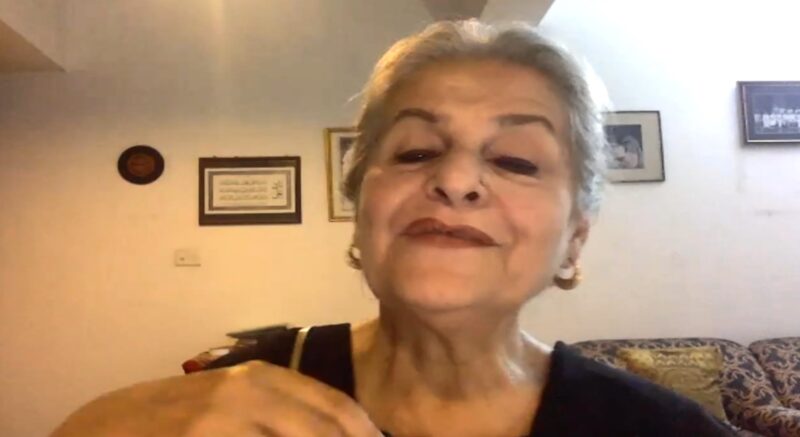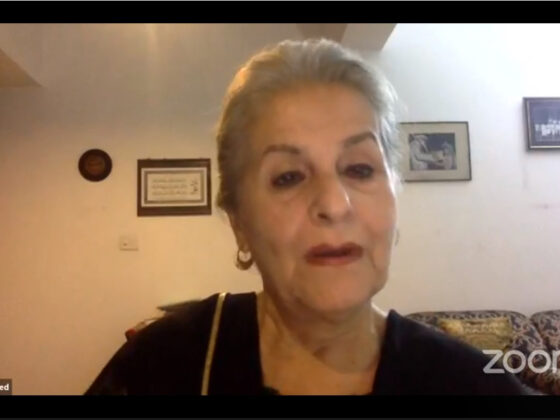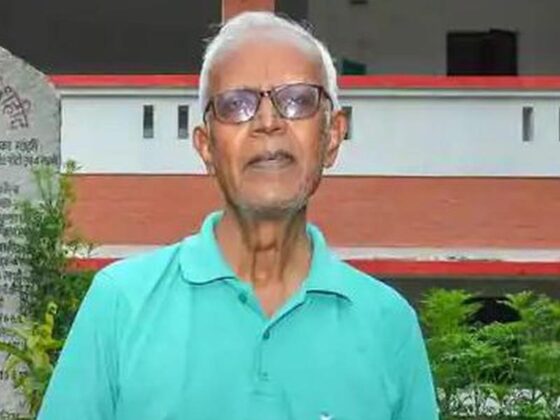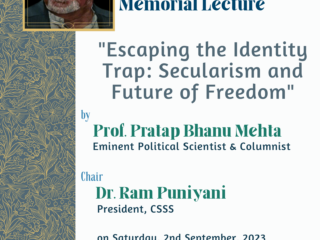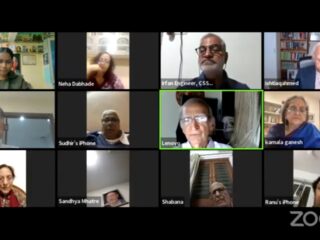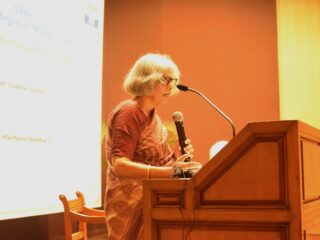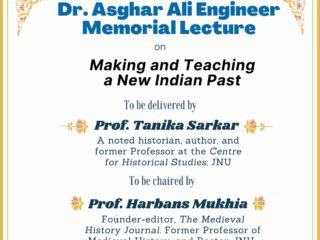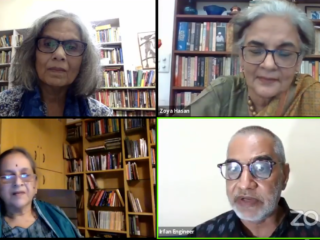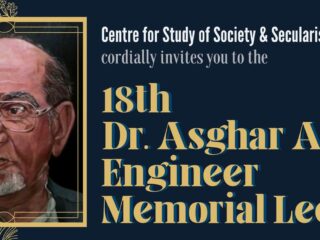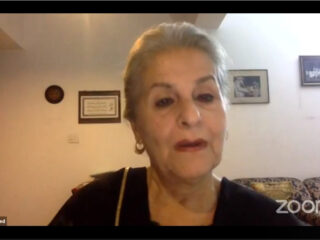(17th Dr. Asghar Ali Engineer Memorial Lecture delivered by Dr. Syeda S. Hameed
on 5th June 2021)
Thank you very much, Professor Indra Munshi for that, generous introduction. I’m certainly very honored to have this opportunity to talk about Dr. Asghar Ali Engineer, whom I used to call Asghar Ali Bhai, at this forum. It is really a privilege to have my dear friend and colleague Prof. Zoya Hasan chairing this session. I’m feel honored. Thank you so very much Irfan, and thank you very much, all the distinguished people who have spared the time to be here, I will immediately get into my subject, which has been very well articulated a couple of times by the previous speakers: “The Contribution of Muslim women to educational institutions: The case of Jamia’s Khwateen-E-Awwal.” I’ll explain that as I go along.
When we talk of Muslim Women Education Pioneers the first name that comes to mind is Nawab Sultan Jehan ruler of Bhopal State. She was born in 1858, ruled for 17 years until her abdication in 1926. She had a lifelong commitment towards women’s education. Not only that, she took measures to improve public health, sanitation, water as well as vaccination drives in her state- almost everything that we consider important today, 150 years later. Her pioneering writing in education was Dars e Zindagi (Education for Life). Many educational institutions in the country were supported with Bhopal state funds. She started Sultania School, Madarsa Biqueesia and Madarsa Victoria; she also established Birjeesia Kanya Pathshala for Shwetambar Jain girls. For underprivileged girls’ education expenses were borne by Bhopal state. She also funded Lady Hardinge Medical College Delhi plus medical and nursing colleges Mumbai and Kolkata. Her example and encouragement led rulers of other princely states to promote girls’ education.
Aligarh held a special place in her heart. While travelling to Bhopal from Mussoorie she stopped in Aligarh. That turned out to be a landmark visit, which ultimately resulted in her becoming the first woman Chancellor of Aligarh Muslim University when it evolved into that premier institution from the original Mohammedan Anglo Oriental College. Her donation of Rs 50,000 towards a grand building on the campus bears her name to this day. The first ever Convocation in 1922 was addressed by her. Thanks to her pioneering zeal, today over 8000 students are enrolled in AMU and over 3000 women from all over India and many countries are enrolled in the Women’s college.
Her gift of a monthly stipend of Rs 100 was for the girls’ school established by a man who became known as Papa Miyan of Aligarh. Shaikh Abdullah (not be confused with Sher i Kashmir of Kashmir, was founder of Muslim girls’ education. Leaders of Aligarh movement were not in favour of separate educational institutions for women and girls. Despite that he strode forward with his wife Waheed Jahan. This is a rare case when his wife, lovingly called Ala Bi, has remained in the public memory. This may be due to the liberal mindset of this far-sighted husband-wife team. When the Muslim Educational Conference was called in 1903 it was an all-male affair. However, under the inspiration of Ala Bi the women were invited to listen, albeit from behind the curtain. In 1904 they started a journal for women called Khatoon to propagate their ideas on women’s education. They raised their five daughters as independent strong women who went on to chart new, even revolutionary paths. The girls’ school they established started in 1906 with a total enrolment of six students.
These exemplary women described above (there were others as well) became my inspiration for working on women of Jamia who I think of as Jamia’s Khwateen e Awwal.
From its inception in 1920, women were a presence and power in Jamia but they never emerged as individuals; always in the shadow of men. Men were committed, dedicated and passionate, but equally so were the women. The strength these women brought to institution building has sadly never been recorded or acknowledged. This is the time, for many reasons, to bring forward these women architects of Jamia. This Forum is ideal because its presiding spirit is that of Dr Engineer, a man who stood firm for women’s rights, no matter what brickbats were hurled at him.
Let me begin with the well-known trio, called ‘Me’maar e Jamia (architects of Jamia) also called the triumvirate. Everyone knows Dr. Zakir Husain, scholar and educationist, who went on to become President of India. Professor Mohammad Mujeeb, is known worldwide by scholars and historians, especially his book Indian Muslims. Dr. Abid Husain is known across the world, especially in Germany, by students of philosophy and Islamic studies. But how many know Shahjahan Begum, wife of Zakir Husain, Asifa Mujeeb, wife of Mohammed Mujeeb and Saliha Abid Husain wife of Syed Abid Husain?
In her speech on Jamia’s Foundation Day held in mid-80’s Saliha Abid Husain wrote. ‘I want to speak of women of Jamia who were were like the raj-mazdoors behind Emperor Shahajahan and the royal architects who built Taj Mahal. They never ever thought of etching their names on the marble’. Of the many ‘mazdoors’ there are two who have left the deepest impression on me. Two women, as different from each other as one can imagine. One of them came to Jamia straight from Berlin in Germany. The other came as a bride to Jamia when it was still in rented buildings in Karol Bagh. Gerda Phillipsborne and Saliha Abid Husain. Saliha was 18 years younger than Gerda. They met in pristine Jamia on the banks of river Jamuna. How the two got connected is a fiction-defying story. It needs to be told, written and captured on lens. Their bond is hard to describe, it is beyond language, culture, even religion.
Gerda came from a German Jewish family of Berlin, an artist, a musician, a litterateur, above all a teacher. Destiny crossed her with three Indian students who had come to Germany for higher education. All were from UP. Zakir Hussain was from Qayamganj, Abid Husain was from Daipur (near Kannauj) and Mohammed Mujeeb from Lucknow. While they studied hard under the best teachers, they found time to meet artists, intellectuals, educationists, all under the gentle tutelage of a woman, Gerda Philipsborn. She rises in my mind as the flower of Berlin in the midst this unique trio.
Thus began a friendship which would last until the very end, at least the end of Gerda’s life. The three used to talk about their dream of establishing a national institution in India under inspiration of Dr. Mukhtar Ahmed Ansari and Hakim Ajmal Khan who they had met in Vienna. Gerda listened carefully to their conversations. As a German Jew she was one of many families who wanted to leave the country because of the impending doom of the Reich. Increasingly, she became attracted to the concept of Jamia and expressed to them her desire to help. They gently discouraged her knowing the hardships that lay ahead.
Gerda was undaunted. She let them go after having given them the benefit of her company, her knowledge, her contacts. When they reached India and the dream began to unfold, Gerda arrived. There she was, a Jewish woman in what was essentially a Muslim institution within a national frame and patriarchal setup. Orthodox no, conservative yes.
Initially she was ‘Memsahib from Germany’ looked at with curiosity by students and staff. How she became German Apajan, loved by the same staff and students is a story which needs to be recalled in detail.
Stories of women of Jamia survive in one amazing book Hamari Jamia which has to be translated in many languages and be made available worldwide. The author, Prof Sughra Mehdi, wrote it with immense will power just before she passed away. If not for her, these stories would have been lost forever. My request to Jamia to have it translated for its own sake as well as for future generations is pending; I feel this is the best time because Jamia has women at the top. A woman VC and woman Chancellor. Let this forum serve as a reminder.
Gerda and Saliha had very little in common; neither culture nor language nor religion; there was however one link, everlasting; their love for Jamia. More than that was their common belief in the human family which transcended geography, even religion. While I can identify where Saliha had got her values from, I don’t know enough of Gerda’s background to trace hers. Saliha came from a reformist family. Her great ancestor was Maulana Altaf Husain Hali who wrote Mussadas e Hali (Ebb and Tide in Islam) exhorting the Muslims to wake up from their lethargy and return to the simple original teachings of Islam; he was also South Asia’s 1st feminist poet. Her father Khwaja Ghulamus Saqlain started the journal Islam aur Asr e Jadid (Islam and Modernity) which was a wakeup call for Muslims. Among her siblings was India’s foremost educationist KG Saiyidain and her first cousin Khwaja Ahmed Abbas legendary journalist, author and film maker, whose birth anniversary we are celebrating tomorrow with a commemorative lecture by P Sainath.
Saliha was on home turf in Jamia. She did phenomenal work despite the hardships of Jamia life but it was done within the comfort of her home and with support of an understanding husband. In Gerda’s case there was nothing familiar. Alien turf, hard living, conservative colleagues, incipient also the entrenched Jewish-Muslim dichotomy. Patriarchy was normal in this stark location of an upcoming institution. It was as a different it could from Berlin; the woods, the gardens, ballets, symphonies, literary gatherings. Above all, rigours of a new language; hers was spoken only by her three friends from Berlin days.
1933 was the year that Gerda and Saliha began to work together. That was also the year when Anjuman e Khwateen was launched. Society for Women; its first chair was Asifa Mujeeb and first secretary was Saliha. In the same year on Jamia’s Foundation Day a woman’s jalsa was held with Begum Mohammad Ali in the chair. 400 to 500 women attended from all over Delhi. Apajan and Saliha were overjoyed. Saliha wrote ‘I don’t know what she saw in me. Perhaps she felt I could help her mission’. She found herself listening and following Apajan in her relentless efforts to get women to participate. She writes that most of them including herself were in purdah but they were urged to come out in their burqas to Jamia events. Soon they began to organise their own events; Mehfils Milads Majlis Mushairas, Plays Bait Baazi. These were women exclusive events but slowly they began to enter gatherings which were traditionally only for men
Having given the best years of her life to Jamia, 1933 to 1943, Gerda died away from her own family and home but surrounded by all her loving colleagues and students. Saliha lived 34 years longer, wrote 50 novels, essays and short story collections. She was in high demand in literary gatherings all over the country. Jamia remained her lode star, her Karmabhoomi. It was her literary heir and spiritual daughter Sughra Mehdi who completed her incomplete writings, wrote her biography and carried on her tradition.
When I was writing about these 2 women, I came across a formal photograph of Arakeen e Jamia which included a beautiful and demure Gerda sitting with Dr Ansari, Khwaja Hasan Nizami and seniors of Jamia. Even Zakir Sahib and Abid Sahib stood behind in reverence. The photograph bears no date but could have been the mid 1930’s.
She is buried in Jamia’s qabristan and her epitaph (if I can call it that) was written by Sughra Mehdi, a woman who never saw her. The epitaph is not on her gravestone. It is at the end of the one and only book on Gerda., Jamia ki Apajan. It’s poetic justice that Sughra, the spiritual daughter of Saliha, should have written it. “What Apajan did for Jamia proves one inexorable fact; no matter what differences exist in geographies cultures and language if we do good work in partnership with true hearts then all differences melt away.”
Turkish freedom fighter, Halide Edib Khanum’s visit to Jamia in 1935 was a momentous event. She was a comrade of Kamal Ata Turk and came to Jamia on the invitation of Hakim Ajmal Khan to deliver 8 lectures. Among the many present were top leaders- Mahatma Gandhi Maulana Azad, Allama Iqbal, Sarojini Naidu. An exclusive women’s function was held later in the home of Asifa Mujeeb where women of Jamia had assembled to meet her. Language was really no barrier when their hearts were beating to the same rhythm. The foundation stone of one of Jamia’s first buildings was laid in the presence of Halide Edib Khanum.
Jamia began to function in its new location on the banks of river Jamuna in Okhla. Houses were built, modest houses, their residents earning very small incomes but filled with enthusiasm and a desire to stay together as a human family in which women became the binding force.
Who were they?
Shahajahan Begum wife of doctor Zakir Husain was from a well to do feudal background. She was beautiful like a Mughal painting; even I can recall her face. With very limited income she ran a house where there was a continuing stream of people who never went back without a meal. She never wanted to push herself in any public forum. With Saliha’s gentle persuasion she agreed but only on condition that she would not be asked to speak. She loved animals; she had goats, buffaloes, chickens who she looked after with great care. Her majestic personality was impressive, dressed in a sari with the pallu draped over her head, busting the myth of Muslim women never wearing sari.
Then there was another woman of great substance who has been sadly ignored and forgotten. Begum Asifa Mujeeb was from Sandila in UP born in a well to do family. Saliha writes that she was able to live with grace and patience within the limited income of her husband; the triumvirate had pledged to draw a salary of 75 rupees. She along with others lived in an environment which was very basic, no running water, no electricity, no roads, no sidewalks. There was a gentleness about her, an embedded dignity. Her gait was majestic, speech was soft, temperament loving to all especially to her husband who she protected from issues of daily hardship. The tragedy of losing a brilliant young son she bore with patience unparalleled. What struck me was her quiet work, teaching and writing. I had the privilege of looking at some of her amazing writings some of which are copied in notebooks in her neat handwriting. A few were published by Maktaba Jamia, Jamia’s publishing house with which she had a lifelong connect. Three books lie before me on my table. Jab aur Ab (Past and Present) Khargosh ki Chaal (Rabbit’s Trick) and Usne kya kar na Jana, a title which impossible to translate, and there lies the fun!
Saliha about who I have written above authored 50 books most of them need to be translated and widely distributed because they are a treasure house of history both of Jamia and pre and post-independence India. She spoke about Women in Islam in the liberal tradition of her ancestor Maulana Altaf Husain Hali and her other buzurgs. She was outspoken and fearless of being ostracised by practitioners of orthodox Islam. But no one dared given her profound scholarship and awesome presence. In1947 she also gave up burqa and wore saris throughout her public life.
There was Nabila Begum from Panipat who taught Quran with meanings to girls from the nearby rural areas. Mushir Fatima was another stalwart who took charge of Nursery School where she spent most of her life. Tahira Begum was Begum Asifa’s sister who came to stay with her when her beloved son passed away and slowly became involved in Jamia and finally took responsibility as warden of the Girl’s Hostel. There was Jamal Fatima, popular name Mimmi Apa who was referred as daughter of Jamia and worked with Mushir Fatima ultimately inheriting her mantle of Nursery School.
So many faces rise in my mind. Habeeba Taban wife of the communist ideologue and poet Ghulam Rabbani Taban, who was from a Jagirdar family. She had no formal education but imparted so much learning to the women around her especially to her daughters who went on to make important national contributions. Another image is of Siddiqa Kidwai whose husband Shafiqur Rahman was Minister of Education in Govt of India. She established the Balak Mata Centre in Maita Mahal for educating girls of the walled city. She sat on many apex committees of Jamia and served as Member Rajya Sabha. But girls education remained her top priority. Saliha writes about her, beautiful and majestic, draped in a khaddar sari; inspiring young girls to wear khaddar.
Begum Saeeda Khurshid is closer to me personally because she was founder president of Muslim Women’s Forum which she nurtured and which has been kept vibrant for 21 years in her footsteps. Her contributions are covered by Saliha and Sughra in their respective writings.
My ancestor Maulana Hali, South Asia’s first feminist poet wrote in 1904 in celebration of women
Ai maaon behnon betiyon duniya ki zeenat tum se hai
Mulkon ki basti ho tum hi quomon ki izzat tum se hai
O mothers, sisters, daughters, you are ornaments of the world
You are life of the nations, dignity of civilisations.
These lines inspired our work on Pathbreakers the 20th century Muslim Women of India. It manifested in an exhibition which aimed to break the stereotyping of Muslim Women as victims of their own societies and personal laws. During the freedom movement many Muslim women shed the purdah and became partners in the project to build a new India. Our research revealed an uncharted history which threw up many treasures. We brought these women out of national oblivion and displayed them before the people of India so that they could view them, peep into their minds and stop stereotyping them as a faceless mass. We featured 22 women; we could have featured many more. Post 1947 they among others were tending to refugees who had fled from the newly created Pakistan they were educating generations of girls in the best liberal traditions of Islam they were cleaning slum and bastis around open settlements. They broke their shackles barriers and post 1947 became architects of an India which was rising from the blood and gore and rubble of the partition.
They wrote, they argued they healed their restored. To name a few. There was Anis Kidwai who wrote of her partition trauma in Azadi ki Chhaoon Mein, which has now been translated in English by her granddaughter, Ayesha Kidwai titled, In Freedom’s Shade. Saliha Abid Husain wrote and spoke fearlessly against triple talaq dowry multiple marriages. Sharifa Hamid Ali represented India in the United Nations. In 1937 she developed a model Nikahnama incorporating in it greater rights for women in marriage. In Satara she started training course for nursing and midwifery. In 1928 she addressed students at Aligarh. No Muslim women had ever addressed them without a burqa. In deference to her, therefore, they stood with their backs throughout her fiery speech. There was Atiya Fyzee, writer and artist who gate crashed at the Jubilee Celebrations of the Mohammedan Educational Conference in 1925 which excluded women. So she began speaking from behind the curtain until she was invited outside and talked direct to the gathering. There was Suraiya Tyabji a artist who designed the Indian flag. Her daughter Laila Tyabji is foremost today in Indian crafts. Speaking at our Pathbreakers Conference in 2017 she gave us a roadmap. ‘My mother and other women portrayed in this exhibition of Muslim Pathbreakers come mostly from enlightened and privileged backgrounds. That doesn’t diminish their contribution but I recall today the many anonymous incredibly gutsy Muslim women I have worked with all over India. We should not forget their courage in stepping out of their burqas and homes to take on roles and identities so different from their cultural roots and upbringing. The Roshanbens, Sairas, Raeesans, Zahidas in Gujarat, Lucknow, Ranthambore and Kashmir who took first steps in braving social prejudice and hostility and opening a path that others could follow.’
This was the roadmap that Muslim Women’s Forum charted for itself as Pathbreakers Phase 2. But because of the global pandemic all of that had to be postponed at least for the time being.
The spirit of Jamia 2019- 2021 comes from these strong and resilient women who collectively built it over the decades. It thereby transcends the test of time and will continue to surface whenever there is a threat to the core values imbibed in the idea of Jamia, the idea of university, the idea of India.
We saw this in 2019, when the women of Jamia stood defiant in the face of oppression. It was these women who protested the unconstitutional Citizenship Amendment Act, 2019 that was passed by an authoritarian state which came to power in 2014. These were women from different parts of the country, coming from different cultures, religions and speaking different mother tongues, but believing in two ideas – Azadi (freedom) Insaniyat (humanity)
They held banners saying “No CAA NRC” “Save Democracy” “Educational Institutions should be safe spaces” “Stand with Jamia” They stood against police brutality and various tactics of the state to curb dissent and free speech. They marched forward when the police attacked peaceful protests with lathis and later tear gas. These women cannot ever be rendered powerless.
Women of Jamia today are descendants of these Khwateen e Awwal of Jamia, of Bhopal and of Aligarh. More power to their spirit. Wherever they go they will shine. To quote our finest contemporary poet, Wasim Barelvi-
Jahan rahega wahin raushni lutayega
Kisi chiragh ka apna makan nahin hota.
Wherever it is placed it will spread light
The lamp has no home of its own.

